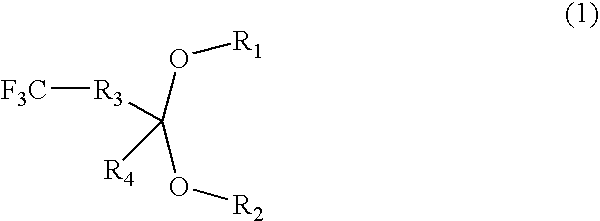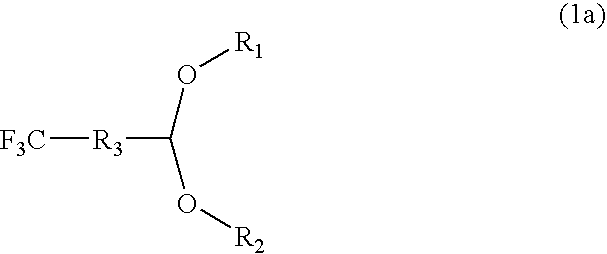Fluorine-containing polymer coating composition, method for forming fluorine-containing polymer film using coating composition, and method for forming photoresist or lithographic pattern
a technology of fluorine-containing polymer and coating composition, which is applied in the direction of multicolor photographic processing, photosensitive materials, instruments, etc., can solve the problems of large material design limitation, swelling and effusion, and underlying parts eroded or cracked (so-called solvent cracks), and achieve high resolution, sufficient dissolution ability, and reduced defects
- Summary
- Abstract
- Description
- Claims
- Application Information
AI Technical Summary
Benefits of technology
Problems solved by technology
Method used
Image
Examples
synthetic example 1
Synthesis of Fluorinated Acetal (A)
[0099]
[0100]Into a 300 mL stainless-steel autoclave cooled with dry ice and acetone was charged a solution of 25.8 g (0.46 mol) of KOH dissolved in 52.5 g (0.69 mol) of 1,3-propanediol and 4.2 g of water beforehand and 30 g (0.23 mol) of (1Z)-1-chloro-3,3,3-trifluoropropene. After temperature was elevated to around 20° C., the whole was stirred for 1 hour and then heated under stirring at 88° C. for 10 hours. When the reaction solution was measured by gas chromatography, other than excess 1,3-propanediol, it contains 1.0% of starting (1Z)-1-chloro-3,3,3-trifluoropropene, 82.0% of 2-(2,2,2-trifluoroethyl)-1,3-dioxane, and 17.0% of others.
[0101]After precipitated salts were filtered off, a fraction of 76° C. to 78° C. / 16 kPa was collected by distillation to obtain 21.5 g (purity 99%, yield 54.4%) of 2-(2,2,2-trifluoroethyl)-1,3-dioxane (fluorinated acetal (A)).[0102]Boiling point: 137° C.[0103]Flash point: 41.0-41.5° C.
synthetic example 2
Synthesis of Fluorinated Acetal (B)
[0104]
[0105]Into a 1 L stainless-steel autoclave cooled with dry ice and acetone was charged a solution of 86 g (1.53 mol) of KOH dissolved in 237 g (7.40 mol) of methanol and 10 g of water beforehand and 100 g (0.77 mol) of (1Z)-1-chloro-3,3,3-trifluoropropene. After temperature was elevated to around 22° C., the whole was stirred for 1 hour and then heated under stirring at 70° C. for 1.5 hours. When the reaction solution was measured by gas chromatography, other than excess methanol, it contains 2.0% of starting (1Z)-1-chloro-3,3,3-trifluoropropene, 83.6% of (1Z)-3,3,3-trifluoro-1-methoxypropene, 10.3% of (1E)-3,3,3-trifluoro-1-methoxypropene, and 4.1% of 1,1,1-trifluoro-3,3-dimethoxypropane.
[0106]After precipitated salts were filtered off, a fraction of 80° C. to 110° C. was collected by flush distillation to obtain 190 g of a mixture. Into the resulting mixture was charged 16.5 g of methanesulfonic acid (0.172 mol), followed by heating under s...
synthetic example 3
Synthesis of Fluorinated Acetal (C)
[0110]
[0111]Into a 300 mL stainless-steel autoclave cooled with dry ice and acetone was charged a solution of 38.7 g (0.69 mol) of KOH dissolved in 71.4 g (1.15 mol) of ethylene glycol beforehand and 30 g (0.23 mol) of (1Z)-1-chloro-3,3,3-trifluoropropene. After temperature was elevated to around 22° C., the whole was stirred for 1 hour and then heated under stirring at 60° C. for 4 hours. When the reaction solution was measured by gas chromatography, other than excess ethylene glycol, it contains 2.0% of starting (1Z)-1-chloro-3,3,3-trifluoropropene, 80.0% of 2-(2,2,2-trifluoroethyl)-1,3-dioxolane, and 18.0% of others.
[0112]After precipitated salts were filtered off, a fraction of 80° C. to 100° C. / 13 to 16 kPa was collected by distillation to obtain 19.1 g (purity 99%, yield 53.2%) of 2-(2,2,2-trifluoroethyl)-1,3-dioxolane (fluorinated acetal (C)).[0113]Boiling point: 120° C.[0114]Flash point: 33.0-33.5° C.
PUM
| Property | Measurement | Unit |
|---|---|---|
| boiling point | aaaaa | aaaaa |
| temperature | aaaaa | aaaaa |
| temperature | aaaaa | aaaaa |
Abstract
Description
Claims
Application Information
 Login to View More
Login to View More - R&D
- Intellectual Property
- Life Sciences
- Materials
- Tech Scout
- Unparalleled Data Quality
- Higher Quality Content
- 60% Fewer Hallucinations
Browse by: Latest US Patents, China's latest patents, Technical Efficacy Thesaurus, Application Domain, Technology Topic, Popular Technical Reports.
© 2025 PatSnap. All rights reserved.Legal|Privacy policy|Modern Slavery Act Transparency Statement|Sitemap|About US| Contact US: help@patsnap.com



